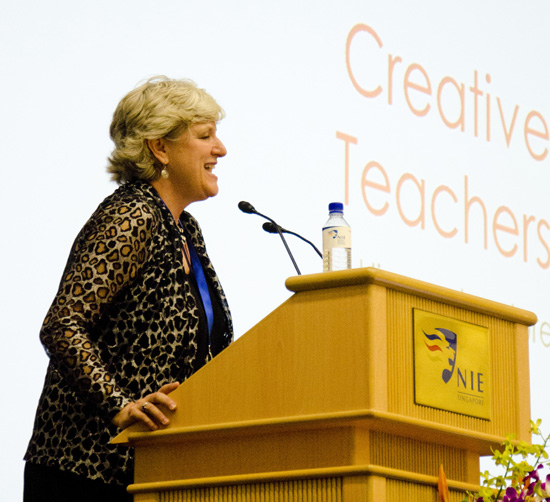Why Singapore’s English Teachers Should Embrace Singlish, Not Fight It
Is it time for Singaporean educators to embrace Singlish as a legitimate learning tool? What the Research […]
Read More
The world has changed tremendously, but has our school curriculum kept up with the changes? Professor Bonnie Cramond calls for the infusion of creativity into the curriculum, which will help our children thrive in the new world. This article is based on her keynote address at the conference.
Much has changed in the last 100 years, but has the curriculum? Not really. We’ve changed the names in the US, but it’s the same division of knowledge into the same categories.
 We’re teaching our children content that will be changing. Some of it will be obsolete, some different, but most of it they won’t remember.
We’re teaching our children content that will be changing. Some of it will be obsolete, some different, but most of it they won’t remember.
The emphasis we should be placing on our students is how to learn and what to do with the information, not just to acquire it. What we can do for our students is to teach them to be resourceful and creative so that they can deal with the world as it changes.
So, creativity is necessary for our society. As recent reports warn us that a nation cannot retain its economic and scientific edge in the competitive world with a workforce that has mastered only the minimum competencies.
Creativity maximizes human abilities. Everybody thinks of Albert Einstein as an intelligent person, which he was, but he saw his creativity and curiosity as much more important than his intelligence and knowledge.
And a lot of people don’t think of creativity in, let’s say, Math. But people can be creative in any human endeavour; you can choose to do it in a more creative way. The famous psychologist Abraham Maslov said, “Good soup is more creative than a bad poem.”
In fact, people misunderstand what creativity looks like. If you’ve taught highly creative kids, you’ll know they’re not the easiest kids to teach. The very qualities that enable someone to be creative are also seen as negative.
You’ve got to ask if your students are being original or bizarre? Independent or stubborn? Have high amounts of energy or just hyperactive? Spontaneous or impulsive? Emotionally sensitive or emotionally unstable? Lost in thought or simply daydreaming?
Here are some creative dispositions I think creative people possess: They are curious, able to take intellectual risk, persistent, tolerant to failing, playful, and open to all experiences.
Years ago, psychologists thought that intelligence was an in-born quality that you had from birth and you kept all your life. We now know that intelligence is very interactive with our experiences.
You might be born with a certain propensity, for a certain intelligence, but how that is nurtured will determine if you reach your maximum potential. The same is true of creativity. We can nurture our creativity or we can stifle it.
I’ve done research on drop-out kids and found out that many of them are not kids who can’t master the basics. They are kids who cannot stand the curriculum in our schools.
All of us are creative in little ways every day, and we use our creativity all the time. You’ve got to recognize and nurture creativity in all students.
And it’s not enough to say that the kids have arts lessons so they’re being creative. What if that child is a creative writer, scientist, mathematician or electrician?
Creativity is not confined to the arts. People who operate at the highest levels in all realms of human endeavour need creativity. We have to infuse it into all subjects and all levels.
I want to make a point that there’s a difference between teaching creatively and teaching for creativity.
There are a lot of teachers who are pretty creative and might think of a creative lesson, but who’s being creative? The teacher is. Teachers can be creative in their lessons but we also want to pull out the children’s creativity.
And I’m not saying we shouldn’t teach any content. You have to know something and the more complex the field, the more you have to know. But we have to maintain a balance that when we’re learning content, we’re also inquiring and thinking innovatively and creatively.
One way to do this is to use real-world methods and data, where students think about things but still learn some basic content. They should also work toward solutions of authentic problems that they care about, with the opportunity to either work individually or in teams.
It’s also important for us to make learning interdisciplinary. After all these years, we still have our separate segments of knowledge, which, in reality, is not segmented. When you use a problem-based or project-based curriculum, students are more likely to integrate what they know.
In the US, we have three states that have declared that schools must assess if they’re teaching kids to be creative. I’m so upset because I looked at one of their criteria, it said, “How many debate classes and art classes do you have?” That’s not what we mean!
Also, student success is measured by tests of what was learned. Problem-solving questions typically consist of set methods and set answers. So the students know this is the problem and this is how they have to solve it.
But those methods do not promote critical or creative thinking. They don’t teach problem solving or problem finding, which is even more important, and they don’t engage students.
Such evaluation should not be more of the same kinds of tests. Instead, we should be looking at assessing the 4Ps of creativity:
Those are things we really need to look at if we really want to value creativity.
In the US, a lot of people have been shaken up about education and what we need to do. So my question to you is: Is Singapore awake?